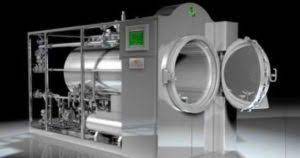Desmond Tutu, alkaline hydrolysis, and the power of celebrity endorsement
 It’s not every day that something that happens with a funeral gets publicity around the world. However, like in other events in the history of the world, there are points that you can look back on in retrospect and say that they could have been turning points in society mores.
It’s not every day that something that happens with a funeral gets publicity around the world. However, like in other events in the history of the world, there are points that you can look back on in retrospect and say that they could have been turning points in society mores.
As I’ve been searching for Funeral Director Daily articles in the past week I’ve been amazed at the number of articles around the world that have dealt with the death care wishes of Archbishop Desmond Tutu of South Africa. As you may know, the South African human rights activist died on December 26, 2021. It was later revealed, as you can read in this article, that the final disposition of his human remains was alkaline hydrolysis, called by some “aquamation”.
As you can read in this article from Essence, it apparently was Archbishop Tutu’s choice as he wanted an “Eco-friendly” disposition.
Since I’ve read these stories on a world-renowned celebrity choosing a form of death care disposition that was not in, what one would call the mainstream of death care, I wondered if this choice by Archbishop Tutu will have an effect on the progress of alkaline hydrolysis as a more mainstream form of human disposition. We certainly don’t know that today, but we might be able to look back at some point in the future and realize that this publicity helped move the process of alkaline hydrolysis into the mainstream of human disposition.
In a historical context it could be argued that the death and funeral choices of President Abraham Lincoln helped move the process of embalming a loved one into the mainstream. It could also be argued that the Lincoln death accelerated the concept of “undertakers” moving into a more professional role with funeral homes taking on a more prominent role in death care.

Tom Anderson
Funeral Director Daily
You may know that President Lincoln was assassinated on April 15, 1865. On April 21, 1865, his casketed body was loaded onto what has become known as the “Lincoln Special”, a train that made its way to Springfield, Illinois, for Lincoln’s burial some 13 days later on May 4, 1865. In between, Lincoln’s body was mourned in 180 cities. . . with a public viewing at 13 of the stops according to this article. This would not have been possible without embalming. Here is a short article on Lincoln’s journey from Washington, DC to Springfield, Illinois, from the History Channel.
I might also argue that the death and public cremation of India’s Mahatmi Gandhi in 1948 brought the thought of cremation to many, including United States citizens, who by that time were traditionally ensconced with the process of earth burial carried out by funeral homes and funeral directors.
So, I don’t know if alkaline hydrolysis will move into the more mainstream of the American funeral process, but the publicity it is getting in the secular press because it was the choice of Archbishop Tutu can only enhance its positive movement among the masses.
Related articles:
- What is aquamation, the burial practice Desmond Tutu requested instead of greenhouse gas gas-emitting cremation? The Seattle Times (WA)
- What is aquamation? The “Green” alternative to cremation chosen by Desmond Tutu and the UK rules explained. iNews (Great Britain)
- What is aquamation cremation? Is it legal and how much does it cost? Republic World (India)
More news from the world of Death Care:
- FEMA Covid-19 Funeral Assistance – State-by-State breakdown. FEMA
- Preparing the deceased for final goodbye is embalmer’s sacred responsibility. Las Vegas Sun (NV)
- Ohio cemeteries, funeral homes in legislative fight over prepaid casket sales. The Columbus Dispatch (OH)
Enter your e-mail below to join the 2,513 others who receive Funeral Director Daily articles daily:






















The Washington Post ran the following article: What is aquamation, the burial practice Desmond Tutu requested instead of greenhouse gas-emitting cremation?
In this article, the author, attempted to explain the process of alkaline hydrolysis. The process was equated with a burial, see headline, and with being part of the green burial movement. Those of us in the funeral industry know neither of these two references are correct. With alkaline hydrolysis 95% of the body is emptied into the sewer for further processing at a waste water treatment center. The biological oxygen demand from the effluent is about 5,000 times greater than what one would normally put into the sewer. The effluent from alkaline hydrolysis is industrial waste. Many waste water treatment systems refuse to accept it. In 2019, the only alkaline hydrolysis systems available to funeral operators disposed of the effluent via the sewer. The outmoded alkaline hydrolysis systems that use solely water and potassium hydroxide form hydrolysate that is full of fats and a pH level above 12. The high fat content and the high pH of the effluent result in a liquid and viscous fat layer that are not conducive for a burial. Most waste water treatment plants require the body to be brought down to a pH between a 9 and a 10.2, before being disposed of in the sewer. This clearly is not a burial.
Had the option for the new form of alkaline hydrolysis been available, the the 95% of Archbishop Desmond Tutu that went to the sewer could have been returned beneficially to the earth in Cape Town. Alkaline hydrolysis 2.0 from Fireless Cremation™ (www.firelesscremation.com) uses a chemical process and system that breaks down the fats and neutralizes the pH to between a 7-8 for a Sustainable Burial. His bones would still have been interred in St. George’s Cathedral. The other 95% of his body could have been “buried” on the grounds of St. George’s Cathedral or returned to his friends and family for them to memorialize him at locations of their choosing.
Another option that Desmond Tutu would have found appealing would have been for his “essence,” his non-bones, to be left with a high pH level and the fats broken down, prior to his body’s essence receiving a Sustainable Burial at Sea. His body would have contributed to reducing the acidification of the South Atlantic Ocean.
As each person only has one try at a funeral, offering families Sustainable Funeral® options that truly align with their values is the right thing to do for families and the planet.
Aquamation would certainly not have been Archbishop Desmond Tutu choice, if the new Sustainable Funeral options were available to him in Cape Town.